BBC's Blog, page 3
February 18, 2014
Connected Studio: innovation in Classical Music
Last week about 100 people gathered at the Wales Millennium Centre in Cardiff to start to come up with new ways to present classical music at the BBC. It was all part of the 'Connected Studio' scheme, in which creative people - from inside the BBC and from outside - are invited to bid for some money to create really innovative applications for BBC content. There's a live blog about it here and consultant Simon Hopkins has written a very comprehensive round-up of the session in Cardiff here.
I kicked off the day with a presentation to the assembled creatives - there were engineers, designers, journalists, producers, artists, musicians and entrepreneurs, all sorts. It was about the history of innovation in classical music. My case was that classical music is not an innovation backwater or a passive customer for innovation but, in truth, the main source of innovation in media, entertainment and broadcasting over the last 150 or more years. I gave five examples:
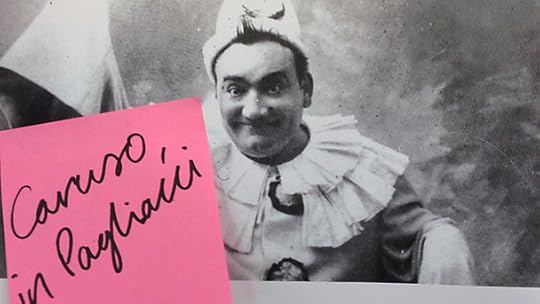
Enrico Caruso
1. The first public radio transmission of any kind - on 13 January 1910 - was a live broadcast from the Metropolitan Opera House in New York.
The great Enrico Caruso sang the role Of Canio in Leoncavallo's 'Pagliacci'. Nobody owned a radio at the time, of course, so receivers were set up on ships in New York harbour, in hotels and public places in Manhattan. It was a sensation in the popular media of the time and, of course, paved the way for music radio as we now understand it.

2. Caruso's recording of an aria from the same role, six years earlier, became what is widely-thought to have been the world's first million-selling record.
The first superstar of the recorded era was a classical artist. Caruso's breakthrough was the beginning of a hundred-year golden age for recorded music which some think may be coming to an end now.

3. From the BBC's own innovation timeline. Our first outside broadcast, when the organisation was only a few months old, right at the beginning of 1923.
It wasn't a coronation or a sporting event but one act from Mozart's 'The Magic Flute', performed by the British National Opera Company, live from Covent Garden.
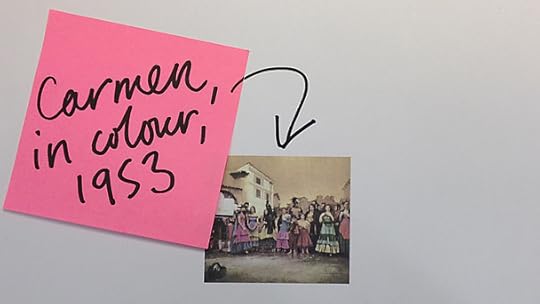
4. 31 October 1953, the first full-length colour television programme in the world, was - you guessed it - a one-hour excerpt from a production of Bizet's Carmen with the NBC Symphony Orchestra under Arturo Toscanini.
It's fascinating that the great conductor and his pioneering broadcast orchestra were seen on television in colour before any of the big stars of the day.

5. Here's my absolute favourite.
It's a remarkable subscription service that delivered live classical music, from a choice of major venues in Paris, including the Opéra de Paris and several theatres, direct to the home.
Customers - including one Marcel Proust in his Boulevard Hausmann apartment - chose their venue for the evening and sat back to listen in their living rooms, on custom-designed stereo kit. The service was called Théâtrophone. We're in Paris in 1881, over thirty years before the BBC existed (this itself came four years after the first ever transmission of music by telephone, in Switzerland, which was - of coruse - an opera performance). This highly-immersive Victorian cyberspace was built on the first of the really big wired networks - the public telephone system and, in many ways, prefigured the on-demand world of online radio today (more about Théâtrophone and other remarkable services, including Budapest's remarkable Telefon Hírmondó, in this blog post.
I've got dozens more examples - I could have brought you stereo radio in Berlin the 30s, movies with synch sound in the 1890s, cinema simulcasts in the twenties, nineteenth century audio relays to City squares, all driven by the peculiar economics and the hunger for new audiences in classical music.
To finish: in 1865 when Wagner, for the first time, in his new opera house in Bayreuth, put the orchestra out of sight, in a pit in front of the stage, he was doing what all these other innovators had done. He was removing barriers, bringing his audience closer to the music, to the compelling experiences and vivid stories that it offers.
What all of these innovations have in common is a real impatience with the limitations of the old ways of making classical music available and a real sense of the urgency of doing so.
With the latest Connected Studio we want to renew this sense of urgency and put classical music right back at the centre of innovation.
Steve Bowbrick is Editor of Digital, BBC Radio 3
February 17, 2014
Links: new BBC iPlayer Radio, Connected Studio and Behaviour Driven Development
The latest on changes to the BBC iPlayer Radio can be found in Dan Bean's blog post. Roger Bolton and radio listeners quizzed Mark Friend (Controller, Radio Multiplatform) on this week's Feedback (interview starts two minutes in) and comments are still open on Dan's post.

The impressive Wales Millennium Centre was the venue for last week's Connected Studio
If you missed last Tuesday's Connected Studio in Cardiff on Classical Music there are selected pictures on the live blog. Simon Hopkins wrote up the event on the Turner Hopkins blog:
"Steve Bowbrick, Head of Digital at Radio 3 then talked us through some of the issues at stake today. I was particularly taken with his observation the Classical Music had for decades been at the cutting edge of technology, citing, among other things, the world’s first subscription music service, Théâtrophone, provided over the phone in 1881 (which Steve referred to as a “highly immersive Victorian cyber space"..."
You can follow Connected Studio on twitter @BBC_Connected.
The BBC College of Technology published a video and article on "Behaviour Driven Development":
"Behaviour driven development (BDD) is a workflow for software development, inspired by the habits of the most efficient Test driven develpment (TDD) teams. It aims to bring together best practices via a clear and simple language... BDD helps teams to translate the business requirements into a language the software developers can implement. The methodology refers to this as a ubiquitous language."
Two weeks ago the BBC published a technical review by consultants Accenture on the Digital Media Initiative which was picked up last week by ex BBC man Bill Rogers. The report includes a glossary of various technical terms and project najmes. For example, here's the definition of "soak test":
"Test involving a higher workload that the system is expected to handle. This can show breakpoints and can help with future capacity planning. The load can be achieved by either increasing users (preferable) or reducing/removing think times."
Steve Hewitt in the Guardian last Monday commented on various BBC technology related matters, including DMI and You View while later in the week Andrew Orlovski in the Register was caustic about the "Year of Code" but also suggested some alternative ideas.
Have a great week.
Nick Reynolds is Editor, BBC Internet blog
February 14, 2014
BBC iPlayer Radio: your feedback
I’m the senior product manager for BBC iPlayer Radio.
We’ve been making some changes recently to both BBC iPlayer Radio and BBC iPlayer and I thought it would be useful to summarise these below and talk about how we’re addressing some of the issues you’ve raised.
On the 23rd of January we launched a new homepage for BBC iPlayer Radio, improving on the range of features that were available before and matching the most used elements of BBC iPlayer. We carefully tested this new page with users of both BBC iPlayer and BBC iPlayer Radio before releasing it and found that it was easily understood and liked by both groups. You can find more information about the changes we made in one of my previous blog posts.
On Monday of this week, in line with our strategy announced some time ago, we closed a number of the radio pages in BBC iPlayer and redirected you to equivalent pages in BBC iPlayer Radio such as our new homepage, network homepages (e.g. http://www.bbc.co.uk/radio4extra) and category pages (e.g. http://www.bbc.co.uk/radio/programmes/genres/drama/player). A lot of these pages were being duplicated in BBC iPlayer.

A view of the Radio stations in the BBC iPlayer radio homepage
Since Monday’s change a number of you have got in touch to tell us about various issues. I’ll go through some of the most common ones below and explain what we’re doing about them.
Favourites
I mentioned in my blog post on 10th February, that if you had added radio programmes to your favourites in BBC iPlayer you wouldn’t be able to access that list in BBC iPlayer Radio. We appreciate that this is inconvenient and we looked really carefully at whether there was a way of transferring those favourites across, but unfortunately we couldn’t find a simple way to do it. BBC iPlayer favourites is built on technology which is now fairly old and fragile and the advice of our technical experts was that it would be too difficult to retrieve an accurate list and migrate this from cookie based favourites (BBC iPlayer) to signed-in favourites (BBC iPlayer Radio).
The list of radio programmes you favourited in BBC iPlayer is stored in an old programme information database. A request to retrieve your favourites from this database would not give a complete list, it would only return those programmes which are currently available to listen to. To get the full list we would then have to ask a different database directly, however that database doesn’t differentiate between TV and radio programmes.
Additionally, some users have different favourites on different browsers (on the same PC) and devices as they are stored separately for each browser and device, meaning we wouldn’t know which set of favourites to transfer across – the ones from your phone, tablet or PC.
If you need a reminder of your current BBC iPlayer favourites so you can add them in BBC iPlayer Radio they will be visible for a period on this page.
You can add favourites in BBC iPlayer Radio as long as you’re signed in to the BBC, via BBC iD, and this has significant advantages. Firstly, it will help to make sure this problem with transferring favourites doesn’t happen again. Secondly, it means you can now access your favourites via BBC iPlayer Radio across any device on any browser when you sign in, making it easier for you to keep track of your favourite programmes. We will shortly be releasing a new version of the BBC iPlayer Radio smartphone application which includes favourites, meaning you can add programmes from a computer and quickly access them from your mobile device.
Some of you have had trouble with adding series to your favourites. It’s worth noting that if you add an individual episode as a favourite then the series that it’s part of will automatically be added to your BBC iPlayer Radio favourites . You can see your favourite series here if you’re logged in with your BBC iD.
Another problem you’ve raised is that the favourites page in BBC iPlayer Radio should have clearer information and be easier to use. We take your feedback on board and are in the process of updating it to better display the series and episodes you’ve added. For more on the changes to favourites please see this FAQ.
Pausing and resuming an episode
A number of you have noticed that the feature in BBC iPlayer which allows you to pause and resume an episode wasn’t working in BBC iPlayer Radio. We’re glad to say that we have now fixed this so you can now pause and resume when you’re listening on episode pages in BBC iPlayer Radio too.
Listening to Radio 1 and 1Xtra using Google’s Chrome browser
In the last week or so it wasn’t possible to listen to BBC Radio 1 and BBC Radio 1Xtra using the latest version of Chrome (version 32). We’re pleased to say that this issue has now been resolved.
What’s on
Two related issues you’ve raised have been not being able to make a side by side comparison of radio station schedules and not being able to move backwards and forwards in time across schedules. In fact, it is still possible to see what’s currently on air across all the national and nations stations on one page if you click on ‘Stations’ here. You can also see the full schedules for individual stations if you click on one of the station logos on that page and then click on the ‘Schedules’ link near the top of that station’s homepage. At the top of a radio station’s schedule page (for example: http://www.bbc.co.uk/radio4/programmes/schedules/fm) you can click on the dates to move forwards and backwards in time. We’re also planning to investigate the best way to show the schedules for lots of stations side by side on one page. I’ll keep you posted on our progress. Some of you may have seen that we have done something like this in the BBC iPlayer Radio mobile app so we will look at how we can bring that to these pages.
We’re monitoring how people are accessing the schedules and will continue to refine these in response to your feedback and how people are using them.
Categories
Some of you have pointed out that the category pages we link to contain episodes or series that aren’t actually available to listen to. We’re planning to change these links within the next few weeks to link to programmes currently available and ordered by A-Z. In the meantime, there are a few different ways to look at which programmes are in a category. For example, if you want the comedy programmes on Radio 4 Extra that are available now for listening and you want to order them so that the newest episodes are at the top of the list, then this page will do that for you. Down the left hand side of that page are a number of links which you can click on to change the list.
Too many clicks
Finally, some of you have found it harder to get to the items you want. We’re monitoring how people use BBC iPlayer Radio and looking at how to reduce the number of clicks for the most common user journeys. We’ll be working to incorporate those amongst the other improvements we’ll be making to BBC iPlayer Radio over the coming months.
As I hope this blog post shows, we are listening to your feedback and trying to address the issues you’ve raised where that’s possible. Some of these issues can be fixed relatively quickly whereas others may take more time and thought before we come up with the solutions that best suit the full range of ways that you want to use BBC iPlayer Radio. In the meantime comments on my previous blog post have been closed but I’d welcome further feedback here or via the Feedback page.
Daniel Bean is Senior Product Manager, BBC Radio iPlayer, BBC Future Media
College of Production Round Up: Internet radio and Google+
Finding the right audience for your content is a constant challenge for producers, programme makers and DIY broadcasters alike.
As the College of Production examined this week, more and more die-hard radio fans are finding and consuming their favourite music and speech radio via internet stations. For programme makers, internet radio offers global reach for minimal cost. Stations are free to listen to, independent of any broadcaster or network, and targeted specifically at niche audiences around the world.
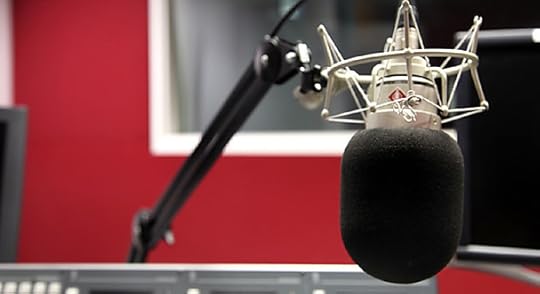
But how is it all put together? Is starting your own station really as simple as sticking something up on iTunes or YouTube? How ‘free’ is streaming software like WinAmp? How will your connectivity affect how many listeners you may get? And what costs do you have to factor in when setting up? A panel of internet radio experts told us more in a passionate and lively conversation.
One of the reasons people are moving to internet radio may well be that more 'traditional' radio is not giving audiences what they want, so we opened up yet more lively debate, this time on the subject of speech radio.
You’d be forgiven for thinking that no-one under the age of 25 listens to speech radio. So, if networks are struggling to maintain and grow their audiences, are radio commissioners missing a trick by ignoring them? We worked with six budding radio producers on the BBC Radio Journalism Apprenticeship Scheme to examine this very issue and gave them a simple task – create an online podcast for the College of Production which answers the question: 'Speech Radio – can young people do without it?'
The results – a variety of voices and views that challenged BBC perceptions of speech radio. Their podcasts set out to encourage current programme makers to think differently and shake up BBC commissioners’ ideas of how to reach new audiences in new ways. They’ve impressed the great, the good and the powerful across the BBC and they’ve now been published on Radio 4’s website along with ours – not bad for a first project.
Finally, we found out what’s happening at The Fox Problem. Quite a lot, it turns out. It’s the world’s first live entertainment series to be delivered on a Google+ Hangout – live entertainment broadcast solely online, and currently causing a social media storm.
With a Twitter reach of 6.9 million in six weeks, people can watch content through Facebook, YouTube, G+, Instagram and Tumblr. They also are successfully using micro social videos in Vine and Instavideo, and other publications and sites can embed the live stream onto their home pages.
They’ve now linked up with a major technology brand for the next series of live YouTube shows, on demand video content and live events, so the recipe seems to be working. It’s an intriguing development in entertainment TV and one to watch.
Denise Roach is a Content Produicer for the BBC College of Production
February 13, 2014
CBeebies Playtime App: Andy's Dinosaur Adventure
CBeebies Playtime is an app for the BBC’s youngest audience of 0-6 year olds. Available on Apple iTunes, Google Play, Amazon and Windows 8 app stores since August 2013, the app has been downloaded nearly 2 million times in under 6 months.
The Playtime app is filled with lots of CBeebies favourites, fun features and great games designed to aid child development, allowing children to learn whilst they play, in a safe and secure environment.
To keep little ones entertained, the CBeebies Playtime app has seen two new exciting additions since its launch last year; and I am very pleased to announce that things are about to get prehistoric, with the third new arrival Andy’s Dinosaur Adventure game!
Children can travel back in time and join Andy on a dinosaur adventure; take care of their very own dinosaur, find out what food it likes to eat and help Andy feed it, teach it to ROAR, personalise it by changing its colour or even take it’s photograph to keep and share with their family and friends.

Andy's Dinosaur Adventures
The fun doesn’t stop there! We asked our audiences ‘What would be the best thing you could do with a Dinosaur?’ and we had some brilliant answers ranging from ‘go to my Nana’s with it’, ‘show a dinosaur a clock so they know the time’ and ‘go to the supermarket with it’, but one of the best answers helped inform part of our Andy’s Dinosaur Adventure game - ‘Ride it!’. With the CBeebies Playtime app, little ones and even big kids too, can ride on their very own Dinosaur. By moving their device around they can also collect photographs of other dinosaurs they see along the way for Andy to take back to his friend Hatty at the National History Museum.
Andy’s Dinosaur Adventure game also allows children to use Andy’s iconic ‘Gizmo’ to learn interesting things and fun facts you didn’t know about dinosaurs; how big they were, how much they weighed and lots more!

We hope little ones will enjoy this game as much as we enjoyed making it for them.
‘Shiver me timbers’ – there’s more! Make a Picture has been treated to a ‘Piratey - Swashbuckle’ make-over in this latest update, which means children can have fun creating swashbuckling artwork with pirate stickers and frame it all with a buccaneer theme!

Shiver me timbers!
• The ‘Make a Picture’ game was added to CBeebies Playtime in Nov 2013. Designed to inspire imagination and creative play, this has been one of the most popular games in the app with over 4.5 million plays.
• ‘Nina and the Neurons Earth Explorers’ a strategy game that lets children explore our Planet and the Solar System, was added just before Christmas in Dec 2013 and has also proven very popular receiving over 3.4 million plays since launch.
• A constant favourite with our young audience is the Something Special, Paint Pop game with 4.6 million plays in the last 3 months alone.
• Tea time still seems to be the most popular time of day with usage peaking between 6pm – 7pm
• Sunday is the most popular day of the week for little ones to indulge in CBeebies Playtime
Insights
CBeebies Playtime has been played over 22 million times at an average of nine minutes each time over the last three months. That’s over 198 million minutes of CBeebies Playtime enjoyed by little ones across the UK, giving us lots of valuable feedback and insights into what our audience like and how they use the app.
The festive period brought lots of Christmas cheer and an increase of nearly 300,000 downloads for CBeebies Playtime with 46,000 downloads on Christmas day alone!
We know that tablets are becoming more and more popular amongst families with small children. Between launch and Christmas day on average 56% of children used the App on a tablet compared to 44% on mobile. However it seems that Santa must have been extremely generous as that jumped up to 62% tablet - 38% mobile after Christmas day.
What’s next
Many of you Grown-Ups have told us what you and your little ones love about the app, what their favourite game is and what you’d like more of. We are always interested in your suggestions and ideas and we have some more exiting updates coming for you soon in 2014, including new words for Alphablocks!
Lizzie Leadbeater is Senior Producer, CBeebies Interactive
February 12, 2014
Connected Studio: how we made The Inventors
We are about to launch our digital story "The Inventors", the result of several months work as part of the Connected Studio for Comedy. It has been a really interesting, exciting and challenging process and I hope you like the end experience.
We set out to work with colleagues in Future Media, and the digital agency Kanoti to explore digital storytelling by creating an extra online episode for the fantastic new series from Steve Pemberton and Reece Shearsmith "Inside No. 9" which has just started airing on BBC Two.
In order to see this content you need to have both Javascript enabled and Flash Installed. Visit BBC Webwise for full instructions. If you're reading via RSS, you'll need to visit the blog to access this content
Behind the scenes of Inside No,9 online episode - The Inventors
Things went more or less according to plan, but like all creative projects, there were a few bumps in the road. Ed Hime had written a brilliant story, but we needed to make sure it would work as a scrolling set of images with audio as opposed to video. In the process, the script naturally evolved, adding depth to the story as we went through several drafts. This posed a challenge in creating the interactive experience, because unlike film and TV where you have a great flexibility in re-arranging, adding and deleting sections of story at the end of the process, with this format it was more difficult to chop and change things without having an impact on the production time.
Like all digital projects, such as games, hopefully things will evolve so that in the future we have tools to create new stories more quickly and easily, but in the meantime, we all worked closely to ensure we could honour the script and make the experience as rewarding as possible while at the same time keeping the production manageable.
We cast Dan Renton Skinner (Shooting Stars, House of Fools) and Tom Verrall (Hotel Trubble) as the two brothers in the story and it was an interesting shoot because we were creating 'Cinemagraphs' rather than video. This meant the actors had to distill each moment into a short expression or movement which could be repeated in a loop. It was strange for them to begin with but by the end I think they got the hang of it. It's not so very different from normal TV production, but perhaps closer to a photographic shoot, with the audio recorded separately.
The end result allows you to dwell on individual images and appreciate the detail, in contrast to normal web browsing which seems to encourage you to consume small chunks of text, images and short video clips as fast you possibly can in order to get on to the next thing. It has been optimised to work on tablets, because there is something satisfying about using a touch screen to swipe and scroll through the story, but it's something you can enjoy on a desktop, laptop or smartphone too.
We also found that the audio became especially important to help tell the story - as in radio, to indicate when people were entering and exiting rooms for example. And we found that we needed to make the experience as easy and intuitive to use as possible. It is not highly interactive like a game, but nor is it entirely passive like television, it exists somewhere in between.
As screens continue to proliferate and it becomes possible to enjoy entertainment on any device in any location, it's interesting to consider how to best deliver engaging stories. It's easy to think of video as the best way of delivering scripted comedy, but hopefully this project shows the potential for using media in different ways to create an immersive storytelling experience.
Jon Aird is a Producer in BBC Comedy
February 11, 2014
Winter Olympics; a new approach to the BBC's live event coverage
Hello, I'm Johnathan Ishmael, a Technical Development Lead within BBC Sport in Salford. Over the past few months our team has been working on a project to deliver digital live event coverage across the BBC in a new way.
The aim was to build a platform for live events that can be easily tailored to suit a wide range of events, which we can continually iterate and improve over time to provide the best-possible experience across four screens - PC, tablet, mobile and connected TV. The underlying technology also had to be scalable across the BBC, giving us the capability to bring even more live events to audiences digitally.
You may have already seen this project in action during our Beta period from late November to the end of January through our new format Sportsday Live pages. We've been listening to your feedback during the Beta and improving the experience, as well as releasing new features.
I am pleased to announce that last week we took the product out of Beta for BBC Sport’s coverage of the Winter Olympics on 7 February.
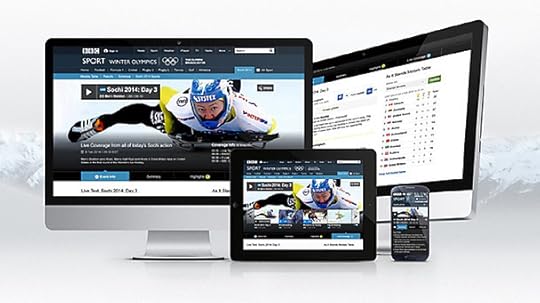
Sochi 2014 on four screens
The following day turned out to be a big test for the new platform as our live Sochi, football and RBS Six Nations coverage helped drive a number of digital BBC Sport records on Saturday 8 February, including:
• 10.1m global unique users – the highest number outside of the London 2012 Olympic Games
• 7.3m UK browsers – again, the highest outside of London 2012
• 3.4m unique UK mobile browsers - highest ever, including London 2012
• 1.5m unique UK browsers on tablet - on a par with the previous all-time high on New Year's Day 2014
• Highest reach on Connected TV since the London 2012 Olympics with a 200% week on week increase
We’re delighted so many people choose to use BBC Sport's products during major sports events and we hope they enjoy doing so.
To give you an insight into our aims for this project, when we started out our aspirations were to create a live experience that could:
• Showcase a wide variety of content from around the BBC, including live video and radio, clips, statistics and live text commentary posts
• Deliver this breadth and depth of content to audiences in one place, faster than would have possible using previous technology
• Responsively deliver all web content to all devices regardless of screen size in a consistent user experience from mobile, tablet to desktop
• Use the same architecture to deliver content to connected TV and mobile applications
• Provide a re-usable and scalable platform that can be used to deliver live events across the BBC
The Winter Olympics is the first major event to use our new live platform. Here are some details about the technology behind the responsive website and some of the benefits it brings to audiences.
How is it different?
Unlike traditional web pages which are typically assembled by code (e.g. PHP) on a server, the new live pages are partially assembled by code on your device using JavaScript. Your device receives a single stream of data updates (such as results and text commentary updates) and uses this information to draw the page.
As we don't send presentation information to your device we can update the page more frequently. Content such as results and live text commentary are delivered twice as fast as the old site, whilst keeping your data bills low. This allows us to provide a more timely second-screen experience as we can publish content into the page at the relevant point in the broadcast.
One further benefit of this approach is that we can select and interchange the items the user sees on the page; for example, a results table, a video or festival set list. This provides a powerful mechanism when covering live events as we can adapt the page at a moment's notice to show the most relevant content, all without the user having to refresh.
How does it work?
Using our in-house content management system a journalist builds a live page, giving it a title, image and duration. The journalist can also associate this page with an event or competition, as well as media such as television or radio shows. When loaded on a device the page then fetches the relevant data, for example video and scores. The page then continues to monitor for updates, so that any updates from the journalist appear straightaway.
For the technology we chose AngularJS, a JavaScript framework. The decision was made after a prototyping phase using different Javascript MVC frameworks including Backbone and Ember. AngularJS works by creating custom tags within the HTML, which act as hooks in which to put the data.
AngularJS has a separation between the business logic code, which converts the data for the view, and the presentation code. Two way data bindings mean we update our data and AngularJS takes care of updating the HTML to match. Unlike some of the other JavaScript frameworks it requires no direct DOM manipulation. More information on AngularJS including code example and presentations can be found on the AngularJS website.
To the future….
Over the coming months the team is working to create new features and optimise important aspects of the site, such as performance. The live platform has been developed as a framework that can be reused within the BBC, across even more live events and BBC products. We've got some amazing live events for Sport in 2014, including the World Cup, Wimbledon and the Commonwealth Games, and the BBC will be working to offer the same experience for a greater range of news, cultural and music events in the future.
I hope you enjoy our digital live coverage using the new live page,and I am always keen to hear what you think, so please do leave a comment.
Johnathan Ishmael is Technical Development Lead, BBC Future Media Sport.
February 10, 2014
BBC iPlayer Radio: the place to go for BBC Radio online
I’m Daniel Bean, the Senior Product Manager of BBC iPlayer Radio.
Just over two weeks ago we launched a new version of the BBC iPlayer Radio homepage which I talked about here. The new homepage looks like this:
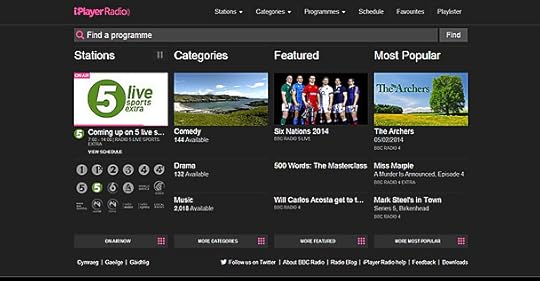
The new BBC iPlayer Radio homepage
From today users who listen to radio via BBC iPlayer using a desktop browser will be redirected to the new BBC iPlayer Radio homepage.
I thought I’d take this opportunity to look at some of the differences you might notice if you used to find radio programmes via BBC iPlayer using a browser and are using this page for the first time. I’ll also look at some of the feedback about the recent changes from those of you who were already using this page for your radio needs.
One of the advantages of enhancing this webpage is that we can now have just one homepage that gives a taste of all radio across the BBC. We hope this will make it less confusing for users who previously had a different experience on the radio page in BBC iPlayer.
We’ve designed the new BBC iPlayer Radio homepage based on the experiences that are most important to you. Categories and Most Popular are now more prominent, as we know this is your favourite way of finding radio programmes, including actual examples of the most popular programmes and top categories so that you can easily get straight to the programmes you like. Alongside that, you can now get to the national and nations radio station homepages with one single click. You can also visit this page across a range of mobile and tablet devices, as well as on desktop computers.
If you added radio programmes to your favourites in BBC iPlayer you won’t be able to access that list in BBC iPlayer Radio. We looked really carefully at whether there was a way of transferring those favourites across, but it turned out to be either extremely difficult or in some cases impossible. Additionally, some users have different favourites on different devices as they are stored separately on each device, meaning we wouldn’t know which set of favourites to transfer across – the ones from your phone, tablet or PC.
You can still add favourites in BBC iPlayer Radio as long as you’re signed in to the BBC, via BBC iD, where they will be saved from now on. Importantly this also means you can now access your favourites via BBC iPlayer Radio across any device on a browser when you sign in, making it easier for you to keep track of your favourite programmes. We’ll also be adding favourites into the BBC iPlayer Radio mobile application very shortly, something many of you have been asking for.
Another difference you may notice is that when you’re catching up on programmes that you’ve missed the new radio homepage leads you to pages that look like this:
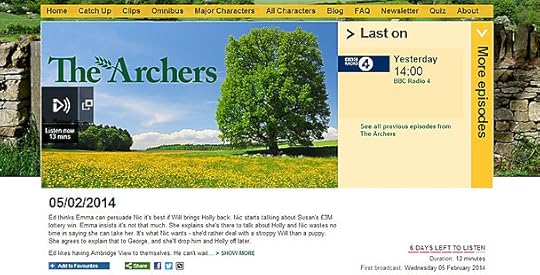
These look different from the ones you may have previously used in BBC iPlayer but their main purpose remains to let you listen again. Over the coming months we’ll be investigating how we can make these pages more streamlined and simple to use, and in fact already have some improvements being released soon.
We’ve had a lot of positive feedback since we launched the new version from those of you that were already using the new BBC iPlayer Radio homepage. This is encouraging so many thanks for letting us know! We’ll continue to listen to what you have to say and take it into account as we continue to enhance BBC iPlayer Radio for you in the future.
So far, two common themes in your feedback were that the pause button next to the ‘Stations’ tab was confusing and that you missed the ‘What’s On’ tab on the old radio homepage. The purpose of the pause button is to stop the automatic cycling of programme images and information that you see if you’re viewing the page on a tablet or desktop computer. We’re aiming to improve that as part of our next update to the page, making it as clear as possible.
You can still see what’s on-air across the stations if you click on ‘Stations’ on the new homepage, though as you’ve pointed out it doesn’t tell you what’s on next. We’re looking at what the best way of addressing this and will aim to have this updated as soon as we can.
As before, please keep the comments coming via the feedback page, or leave a comment below. I hope you enjoy using the new page!
Daniel Bean is Senior Product Manager, iPlayer Radio, BBC Future Media
February 7, 2014
Music Events Platform: a domain driven approach
My name is Chris Thorne and I am a Senior Information Architect in User Experience and Design. I work on the BBCs music events platform, named (after the Glastonbury Founder, Michael) Eavis.
Eavis is the platform that controls and publishes our music events experiences on the web, tablet, mobile and interactive TV. Its purpose is “to present unforgettable BBC performances online in a meaningful, compelling way”.
It is built on the BBC's technical platform, which is service orientated in its architecture, and uses Java at the service layer, PHP at the rendering layer, and relational and object databases for storage.
Eavis delivers the Glastonbury website and last year it delivered Digital Glastonbury. It powers Reading and Leeds, Big Weekend and many other festival sites. It also powers sessions like Live Lounge.
As of today Eavis also powers the performing groups websites which showcase the BBC's orchestras and other singers.
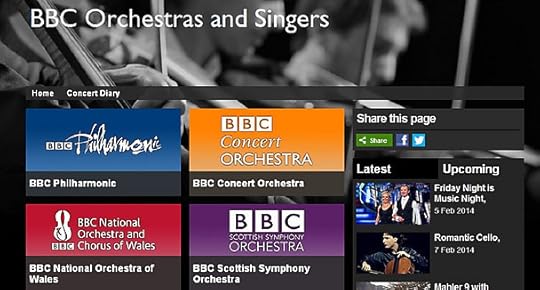
The BBC Orchestras and Singers website (otherwise known as the Performing Groups)

Agile development
For Eavis we take a relatively agile approach. Every few months we set a new goal for the platform, which helps focus our development effort. Our goals so far have been:
1. May 2012 – Deliver Hackney Weekend
2. Nov 2012 – Deliver Speech and Sessions Events
3. May 2013 – Deliver Glastonbury
4. Jan 2014 – Deliver Performing Groups
As you can see, our most recent goal was to replace the old performing groups sites with new, multiplatform Eavis-powered sites.
Each time we set a goal, we make sure it is focused, and achievable in roughly 3 months of development. Each goal is delivered to benefit all events, and gradually expands the capabilities of the platform; as of today the Eavis platform delivers 45 different event brands.
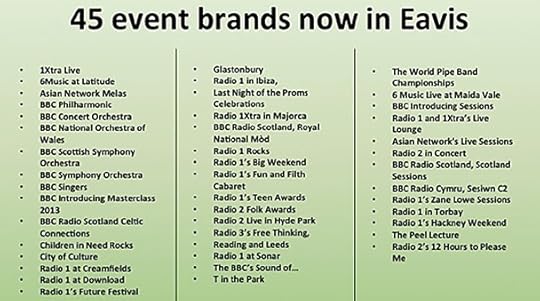
The 45 BBC Music brands powered by Eavis
The Music Events Domain.
In Eavis, we have also taken a domain driven approach, allowing us to:
- Reduce communication errors, since the team shares a common ‘domain’ language – we use the same terms throughout requirements, specifications, code and in the content management system.
- Increase sustainability and reduce maintenance costs of the product. A good domain model should change infrequently, and therefore the shape of the database underpinning the product should change infrequently. This should reduce maintenance costs.
- Create and manage content in a multiplatform way. The content is structured, and aligned to a domain, not a method of presentation. For example, updating information about a performance will update all parts of the experience where that performance information is used.
Michael Smethurst has written about how we make websites before. Past and present colleagues like Michael Atherton and Paul Rissen have presentations you can read about Domain Driven Design (DDD).
Applying the DDD craft to Eavis, we first defined the nouns for the domain, and the relationships between those nouns. The Eavis domain we might call a ‘music events domain’. The nouns (aka things we want to talk about) include Events, Acts and Stages and Performances.
This Domain Driven approach really helps our multiplatform content strategy, in that it doesn’t matter what device you experience a music event on, we still want to create experiences for the entities in the model – events, acts, stages, performances. In the longer term, the content we create should be easy to migrate to a new technology or platform, since the nouns in the domain haven’t changed.
With each new phase of development, once we have a defined goal, we review the model and usually add a small number of new entities or entity attributes.
Most recently, with the addition of classical music events, we needed to be able to promote tickets, and to be able to talk about classical music, and composers and performers of that music.
In the future, we will be improving the way we present our live event coverage, using technologies and user experience patterns developed as part of the BBC's new approach to live events which has launched this month for BBC Sport's Winter Olympics coverage.
I'd be happy to respond to any questions you might have about Eavis and the approach we have taken here.
Chris Thorne is a Senior User Experience Architect, BBC Future Media
January 30, 2014
BBC Weather app hits 5m mark
2014 has barely begun but the popularity of the BBC Weather app goes from strength to strength. This week, the app reached 5 million downloads on iOS, Android and Amazon devices.
Achieved in less than eight months, this milestone feels like the icing on the cake for BBC Weather’s 60th anniversary celebrations earlier this month.
I must admit it has also marked a nice introduction for me to Weather, having joined from News in November, and gives me confidence for our ambitions this year.
Certainly, the response to the app since its launch last June has been fantastic. Consistently high audience reviews and ratings have helped, as well as being named in several end-of-year apps lists.

BBC Weather apps on different devices
Another contributing factor has been changing user trends as mobile and tablet traffic continues to rise. December was the first full month where mobiles and tablets represented half the traffic to BBC Weather. This was probably helped in no small part by a whole new bunch of smartphone and tablet devices being unwrapped on Christmas Day. In fact, Christmas week was our largest week-on-week increase since July, with 244,000 downloads.
Obviously another major contributor was the weather itself. I am well aware there have been some very difficult weather conditions up and down the UK since early December. So it’s humbling to know that so many users have turned to the BBC app for their weather information.
Naturally, we have continued to listen to your feedback, in order to prioritise a number of improvements to the app. Recent updates include ability to rotate your tablet device to view the app in landscape, as well as releasing a version for Amazon Kindle devices, sharing, and installing links to the Met Office National UK Weather warnings.
So what now? Well, more improvement are to come, most notably 10-day forecasts. The website already shows 10 days, but the apps only five. It has been a tricky challenge to find a scalable design that works in the app on a multitude of different screen sizes, but still makes sense to audiences.
We are also using the lessons learnt on apps to start building a new responsive website for Weather, and will be looking to integrate more localised Met Office Weather warnings onto the apps and site later this year.
As always, we will keep monitoring your feedback as we continue to improve BBC Weather’s offering on all platforms.
Mike Burnett is an Executive Product Manager, BBC Weather
BBC Weather app facts
• Weather app downloads so far are roughly equally split between iOS and Android devices
• Peak mobile traffic on Friday mornings from 7am
• Peak tablet traffic on Thursday evenings from 10pm.
• In an average week, a 60/40 split between users on mobiles against tablets.
BBC's Blog
- BBC's profile
- 28 followers



